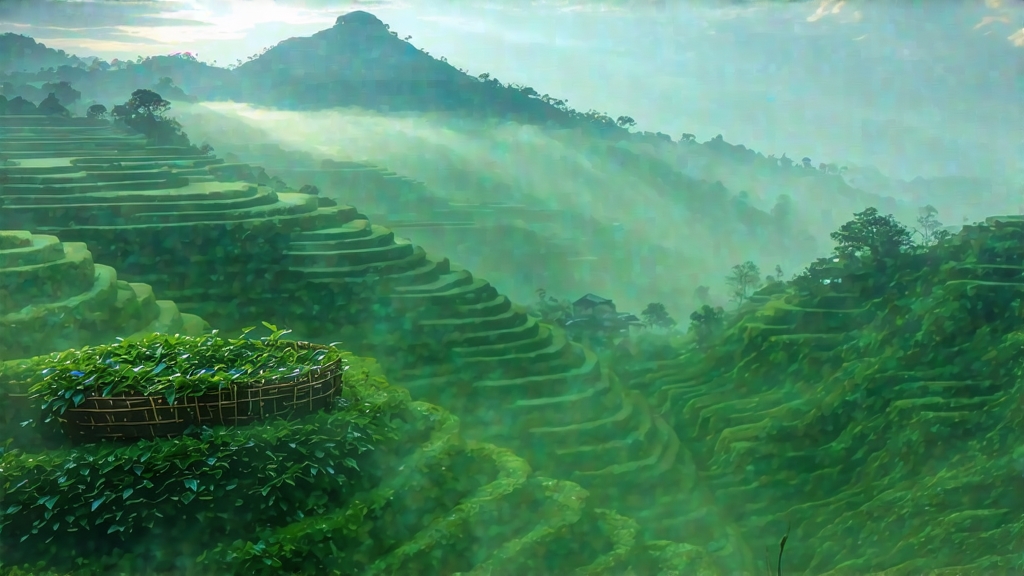
If green tea is the fresh-faced scholar of Chinese tea and pu-erh the bearded sage, then yellow tea is the quiet aristocrat who speaks in whispers only the patient can hear. Among the handful of authentic yellow teas still crafted in China, Meng Ding Huang Ya—literally “Yellow Bud from Meng Ding Peak”—carries the most regal lineage. It was the first yellow tea ever listed as a tribute during the Tang dynasty (618-907 CE), delivered on bamboo sedan chairs down the Min River to Chang’an’s palace gates. Today it remains geographically protected, grown exclusively on the mist-lipped terraces of Meng Ding Mountain, a Taoist sanctuary that rises 1,450 m above the Sichuan basin.
History: From Palace to Near-Extinction
Court chronicles of 742 CE record that Emperor Xuanzong granted Meng Ding tea the status of “Number One under Heaven,” a title later echoed by Song, Ming and Qing emperors. Caravans carried compressed bricks of the yellow bud southwest to Tibet, bartered for warhorses along the Tea-Horse Road. When compressed tea fell from fashion in the late Qing, the delicate yellowing craft nearly vanished; by 1958 only three elderly monks on Meng Ding remembered the full procedure. A state-sponsored restoration project in the 1970s saved the lineage, yet annual production still hovers below 3,000 kg—rarer than the finest Da Hong Pao mother trees.
Micro-Terroir: Where Clouds Touch Soil
Meng Ding benefits from a meteorological anomaly: warm, humid air from the Sichuan basin collides with cold Himalayan fronts, creating a 280-day-a-year fog blanket that filters sunlight into a soft, diffused glow. The tea gardens sit on Devonian sandstone rich in selenium and zinc; morning dew forms on the leaves, then evaporates, then reforms, a cycle that concentrates amino acids—especially L-theanine—giving the tea its hallmark sweetness without astringency. Only the spring harvest, plucked for ten days between Qingming and Guyu, qualifies for authentic Meng Ding Huang Ya.
Plucking Standard: One Bud, One Undisclosed Secret
The pickers—mostly local Qiang and Han women who inherit fingertip techniques from their mothers—work barefoot to feel the soil temperature. They select only the unopened bud and the first half-centimetre of stem, a length locals call “the sparrow’s tongue.” A full kilogram of finished tea demands 72,000 such buds, all plucked before 9 a.m. while still beaded with diamond-cut dew.
Craft: The Invisible Yellowing
Yellow tea’s identity rests on a unique microbiological step known as men huang—“sealed yellowing.” After a brief withering under shade cloth, the buds are wok-fired at 160 °C for four minutes, hot enough to kill leaf enzymes yet gentle enough to preserve surface microbes. The leaves are then wrapped in steamed bamboo paper and left in a 28 °C, 75 % RH chamber for 60–72 hours. During this quiet fermentation, endogenous oxidases re-activate in a low-oxygen environment, turning chlorophyll into pheophytin and forming a golden-yellow polyphenol complex. The process is neither oxidative like black tea nor suppressive like green; it is a controlled autolysis that edges the leaf toward umami without ever crossing the Rubicon of sourness. A second, cooler firing fixes the colour and lowers moisture to 5 %. The finished leaf is slim as a needle, yellow-green with downy silver tips, and smells faintly of fresh chestnuts and orchards after rain.
Grades: Three Tiers of Gold
- Imperial Needle (Cha Zhen): 100 % single buds, length ≤ 1.5 cm, liquor the colour of chrysanthemum infusion.
- Superior Fragrance (Gao Xiang): One bud and one tiny leaf, yielding a rounder body.
- Misty Ribbon (Yun Pian): One bud and two leaves, still delicious but lacking the aristocratic subtlety.
Brewing: The 75 °C Meditation
Water: Use spring water with a TDS between 30–80 ppm; hard water dulls the halo-like sweetness.
Temperature: 75 °C exactly. Boiling water scalds the buds and locks tannins.
Ratio: 3 g leaf to 120 ml vessel.
Vessel: Tall, thin-walled glass or a porcelain gaiwan; transparency